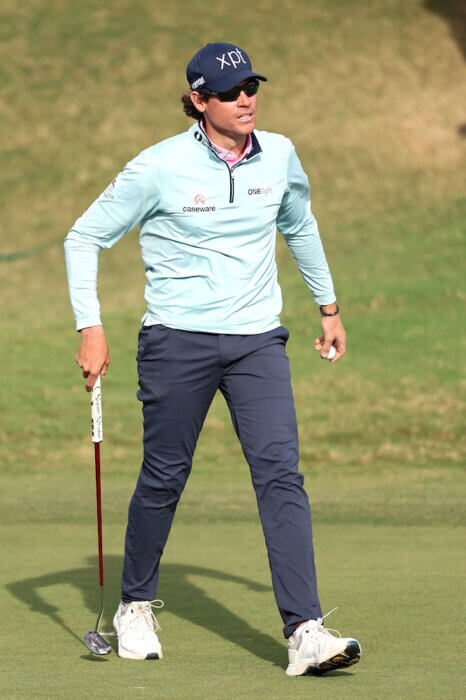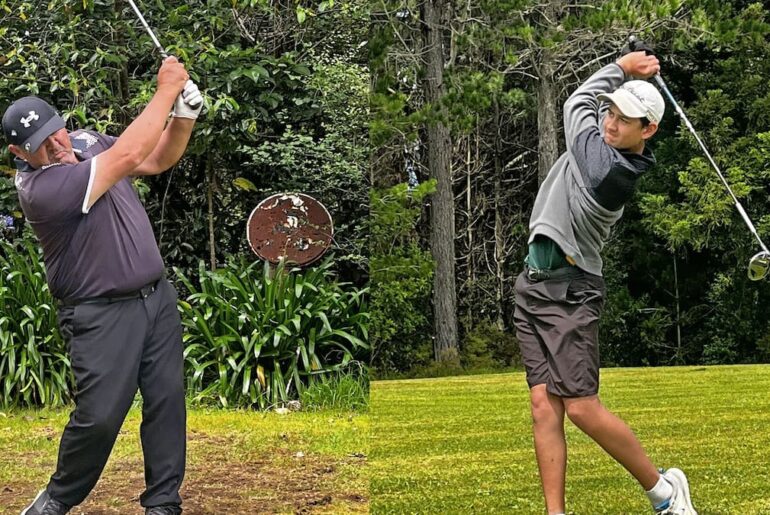 A one-handed putting grip served Adam Schenk fine at the Butterfield Bermuda Championship. Kenneth Richmond, Getty Images
A one-handed putting grip served Adam Schenk fine at the Butterfield Bermuda Championship. Kenneth Richmond, Getty Images
It would have been understandable had 33-year-old Adam Schenk seen himself as what legendary golf writer Dan Jenkins referred to as a dogged victim of inexorable fate.
A golfer chasing a destiny that can’t be changed.
“Too stupid to quit” is how Schenk described himself on the eve of winning the Butterfield Bermuda Championship, his first PGA Tour victory in 243 career starts.
It’s the wicked magic of the game that keeps someone like Schenk – or thousands of others who play their golf without the attendant attention of the PGA Tour – coming back for more despite the frustrations.
It is also the desperate fuel that drives players to defy convention because, frankly, nothing else seems to work.
That brings us back to Schenk, who changed his career path by surviving Bermuda’s gusty winds and, when the conditions were calm enough, putting with only one hand (his right hand) on the club.

It’s one thing to hit one-handed putts on the practice green – it has been a part of Tiger Woods’ pre-round putting sessions – but it’s something else entirely to do it in competition knowing that one more lousy week could force a trip back to Q-School just to keep your job.
That’s where Schenk found himself last week, windblown and wondering if what he was doing was the right thing or just another Band-Aid. The wind, which gusted over 30 mph at times, made it too difficult for Schenk to putt one-handed all the time but the fact that he did it and intends to do it again at the RSM Classic this week is a testimony to his willingness to try something radical.
Call it the any-port-in-a-storm approach.
“I don’t want to say I don’t care what anybody thinks, but I have a belief in what I do and how I do things and that was, that was probably bigger than anything this week is just seeing that belief go through and how I do things,” Schenk said after the victory moved him from 134th to 67th on the FedExCup Fall points list.
“There is a method to the madness. It’s not always right, but that’s fine. I’d rather go down swinging doing it my way and learn along the way and take advice from a small circle. It’s just unbelievable that it finally came true.”
“Then I hit a couple and I’m like, OK, that’s kind of weird. Can you do that in front of people? That’s a big question. Like can you do it on tour? That’s another big question.” – Adam Schenk
When you’ve only made the cut in 11 of 27 starts and twice missed six cuts in a row, there is an abundance of data confirming something needs to change. At age 33 with a wife and two young children, there’s also the nagging question of whether you are doing the right thing.
Then Mike Hulbert shows up.
Hulbert won three PGA Tour events in the 1980s and ’90s and was a steady presence for years on the tour. He also putted one-handed for a full season on the PGA Tour.
 Schenk contends that most players “love the grind.” Mike Mulholland, Getty Images
Schenk contends that most players “love the grind.” Mike Mulholland, Getty Images
When Hulbert saw Schenk searching for a stroke to believe in at the 3M Open in late July, they struck up a conversation. Hulbert explained that he played a complete season without putting his left hand on the putter when he made a stroke.
As Hulbert talked, Schenk saw him hole five of six medium-range putts with a one-handed motion that looked as easy as buttering a warm biscuit.
“Then I hit a couple and I’m like, OK, that’s kind of weird,” Schenk said. “Can you do that in front of people? That’s a big question. Like can you do it on tour? That’s another big question.”
Schenk isn’t afraid to dive down rabbit holes chasing one theory or another and, asked to explain his one-handed putting decision, he went into a dissertation about how the left hand can get in the way of both a putting stroke and on short shots.
In Bermuda, the carpet in Schenk’s hotel room was ideal for practicing his putting so he worked on the one-handed method for an hour, all the while seeing a graphic on the television warning of high winds on Sunday. That meant adding the left hand on most putts but, like children are sometimes told, it was there to be seen but not heard.
“So I kind of let my left hand rest on top. The only thing you can do is line up to it, get a little bit left and take it back smooth and just release it and hit it off the center of the putter. If it goes in, it goes in, great,” Schenk said.
Needing to hole a 4-footer on the 18th hole to win, Schenk – with two hands on the putter – rolled it in and assured his place on the PGA Tour for another two years.
Schenk sounded like he was half joking when he said he should write down his various putting thoughts so he can laugh about them in 10 years but what he found in Bermuda, if only for a little while, was enough.
Is there a lesson there?
“It’s just really difficult to get better at golf is what I would say,” Schenk said. “It’s really challenging. I think it’s something that drives a lot of us to keep grinding and I think most golfers love the grind.”
© 2025 Global Golf Post LLC







